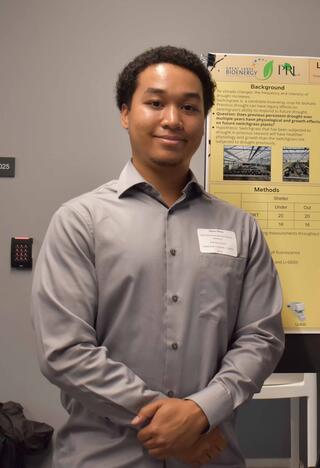Dylan Minor

During the summer, the GLBRC gave me the opportunity to work with Dr. Walker’s lab with mentors Binod Basyal and V Pargulski at Michigan State University. The project I worked on is to determine the legacy effects of drought on switchgrass through previous seasons. We planted 72 switchgrass rhizomes and divided them into two halves:
1) under a rainout-shelter (previously droughted last season) labeled as “under”
2) outside a rainout-shelter (previously well-watered last season) labeled as “out”
Then we subjected twenty under and out switchgrass to drought-like conditions and sixty under and out switchgrass to well-watered conditions throughout the season inside the Plant Science Greenhouses. While the switchgrass was undergoing their respective conditions, we monitored their growth measurements and physiology, such as CO2 assimilation and stomatal conductance. To record measurements of the physiology of the switchgrass, I used an LI-600 and LI-6800 twice and once per week respectively. After the drought phase passed, the switchgrass will was harvested to measure the starch and ethanol. At the end of the research, we hoped to find if a legacy effect of drought influences switchgrass physiology through multiple seasons.
The program allowed me to experience what it’s like to conduct bioenergy research and how to prepare for graduate school, thanks to the many conferences and workshops led by current and upcoming researchers and a trip to the Kellog Biological Station’s research fields. During this time, I’ve made connections with many people inside and outside of bioenergy research and learned how passionate they are in the work that they do. I would like to say thanks to the GLBRC for the amazing experience that they’ve given me and would suggest others to join this program if they are interested in bioenergy and research in general.